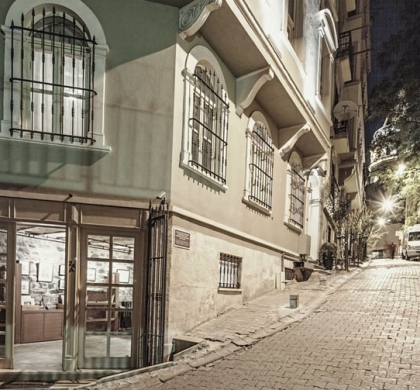Buy or gift a stand-alone digital subscription and get unlimited access to dozens of back issues for just £18.99 / $18.99 a year.
Please register at www.exacteditions.com/digital/cornucopia with your subscriber account number or contact subscriptions@cornucopia.net
Buy a digital subscription Go to the Digital EditionA glorious thistle, the globe artichoke merits better than the usual simple boiling, especially if it is the giant Turkish globe, with its huge mouth-watering centre. Berrin Torolsan reveals how to do it justice
An artichoke flower in full bloom is an exhilarating sight: its purple I have always imagined to be the hue of heroes. Cynara scolymus, the globe artichoke, is a tall, handsome and majestic plant with acanthus-like serrated leaves. On a long upright stem it bears a spherical globe consisting of a cluster of scales, or brats, with pointed prickles on their tops. These scales firmly envelop a magnificent flower and its nectarous calix. In the kitchen garden a few plants will always be left in bloom among the tidy regiments of artichokes to provide the next crop’s seeds. The rest are harvested before the flower buds develop.
The Roman Marcus Gavius Apicius, gourmet host of gourmand emperors in the first century AD, gives us several recipes prepared with artichokes. Pliny, in his encyclopaedia of natural history, written between 23 and 79AD, describes the vegetable as a luxury fit only for the nobility and wealthy…
Sometime between 1620 and 1640, a crossbreed of artichoke unlike any other appeared in Istanbul and acquired its modern name, enginar. This coincides with Murad IV’s Persian campaign. While he was besieging Revan in northern Iran, his governor, Bayram Pasha, was busy rescuing Istanbul’s dilapidated mosques, neglected monuments and ancient city walls – as well confiscating lands, widening roads and knocking down shanty districts in and around the Byzantine walls. When the victorious young sultan returned from his campaign, he was so pleased with what he saw that he rewarded Bayram Pasha with all the lands outside the city walls from the Topkapı gate down to the Golden Horn. On his extensive and fertile estate, Bayram Pasha – who soon became grand vizier – cultivated a very special artichoke, perhaps a treasured souvenier from Persia or a hybrid he developed himself (gardening was a passion with grandees in his day). These magnificent vegetables, with their large orb-like globes and succulent fleshy hearts, won a deserved reputation and were sought after throughout the empire.
Sadly the fertile bostans of Bayrampaşa, the district he gave his name to, fell victim to concrete and industrialisation. But the fame, the name and the variety have survived. Grown around the Sea of Marmara, up in Bursa and down in Gemlik and Darıca, Bayrampaşa artichokes are still very much a part of Istanbul life.
Artichokes remain a delicacy – they were expensive in the past and are still so today. They are one of the few vegetables sold not by the kilo, but individually, costing the equivalent of one or two kilos of other seasonal vegetables. Even so, they are a must in summer in Istanbul, when the hearts, fresh and full of goodness, are cooked in olive oil. Artichokes do not need any spices or strong herbs, and do not go with wine or other alcoholic drinks. The best drink to accompany them is a glass of pure spring water; a cool sip after each mouthful makes the water taste sweet and water also brings out the delicate quality of the vegetable…
Nowadays in Istanbul artichoke hearts are frequently sold on street corners, already cleaned and prepared. All you need do is give them a quick rinse before cooking.
Recipes in this article: Enginar Oturtması (Stuffed Artichoke Hearts), Zeytinyağlı Enginar (Artichokes with Olive Oil), Baklalı Enginar (Artichoke hearts with Broad Beans), Enginar Yaprağı Dolması (Stuffed Artichoke Scales), Crème d’artichauts, Enginar Izgara (Grilled Artichokes).
Zeytinyağlı Enginar Artichokes with Olive Oil
4 globe artichokes of equal size 1 onion 1 medium potato 1 carrot 6 tablespoons olive oil A handful of peas Juice of 1/2 lemon Salt and sugar Fresh dill to decorate
This classic recipe is most common in Istanbul. The dish could well date back to the 15th century. Nowadays it can be prepared effortlessly using ready cleaned artichokes and a pressure cooker. The quicker it is cooked the better as it helps to keep the artichoke hearts white and preserve the goodness. When using a pressure cooker, add very little water – a maximum of two tablespoons – and cook for six minutes.
1 Cut off the stems, leaving 3cms (2 inches) attached to the base. If the removed stems resist the knife, it means they are woody; discard them. If tender, peel off the outer fibrous skin, rub with lemon and drop into water with lemon juice in it. To prepare the artichoke if you are not using ready cleaned and prepared vegetables, with your hands break off the scales from the base, Trim the heart and slice off the remaining soft cone of papery pinkish leaves on top, leaving the choke exposed. Rub the base thoroughly with lemon dipped in salt. Bevel the top edge of the heart. Scoop out and discard the hairy choke with a spoon, wiping the exposed heart immediately with the salty lemon, and drop it into a basin of water with lemon juice in it.
2 Chop the onion finely, dice the potato and slice the carrot,
3 Heat the oil in a shallow pan. Chop the stems and add to the pan with the onion, potato, carrot and peas. Stir-fry lightly and remove from the heat.
4 Cup the artichokes upside down over the vegetables. Pour the lemon juice over and season with salt and sugar. Add half a glass of water and simmer, covered, until the artichoke is firm but tender. Leave, covered, to cool. Serve garnished with fresh dill.
When picking or shopping for artichokes, try to chose those with large heads and firm tightly closed scales. When you shake the globe the stem should be flexible. Store fresh artichokes like the flowers they are, standing in fresh water in a cool place.
More cookery features
Ottoman Athos unveiled: an unprecedented portrait of the glorious backdrop to a thousand years of unworldly devotion and Byzantine intrigue, By Anthony Bryer, with photographs by Graham Speake
On the Great Lake of the Catherine Palace at Tsarskoye Selo, outside St Petersburg, stands this peaceful Turkish bath, an ironic legacy of a century of intermittent warfare
In the garden we may take them for granted, but in the wild, their colours make the heart sing. Andrew Byfield celebrates the vibrant beauty of Turkey’s primulas.
Out of sight of the sea, high above Göcek Marina at Huzur Yadisi, another green peace prevails. In a hidden valley, Richard Tredennick-Titchen found an encampment of yurts that dramatically changed his life.
One of Turkey’s finest birds is the grouse-like Caspian snowcock. To find it takes some organising, for it lives way above the summer pastures in remote areas such as the Aladaglar, the highest part of the Taurus Mountains.



Cornucopia works in partnership with the digital publishing platform Exact Editions to offer individual and institutional subscribers unlimited access to a searchable archive of fascinating back issues and every newly published issue. The digital edition of Cornucopia is available cross-platform on web, iOS and Android and offers a comprehensive search function, allowing the title’s cultural content to be delved into at the touch of a button.
Digital Subscription: £18.99 / $18.99 (1 year)
Subscribe now